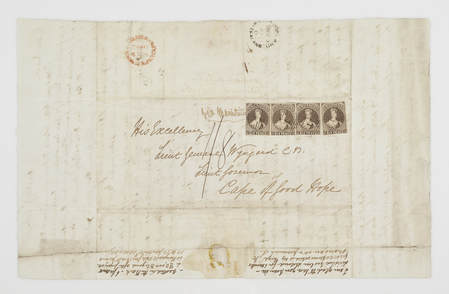SOLDIERS OF EMPIRE
|
Post by Summer Scholar Scott Flutey Over the summer of 2016/17 I worked as a VUW Summer Scholar with the Gerald Ellott philatelic collection at Te Papa (group reference PH859) for the “War by post and bullet” project: transcribing, digitising, and researching items of correspondence relating to Britain’s military presence in New Zealand during the 1860s. The correspondence in the Ellott collection comprises letters between people in private rather than official capacities, thereby providing an important complement to the official record. The project transcriptions and accompanying high-resolution digital photographs of the material are publicly accessible. The Ellott collection contains 343 objects. Of these, 185 objects were digitised and transcribed for this project. These objects involve 141 individuals, who were either senders, recipients or military superiors who authorised correspondence with a signature: often individuals fall into multiple categories across the correspondence. The various postal items which comprise the digitised collection can be grouped into several different categories. 136 are covers (envelopes), eight are entires (letters folded to form an envelope which feature stamps and postal markings on the blank reverse of the letter), and 56 are traditional letters. Most of these items are individual, one-off surviving, pieces of correspondence between senders and recipients. There is also a series of 52 letters from Corporal George Tatler (65th Regiment) to his mother in England spanning the period between 1854 (when Tatler enlisted) and 1865 (when he was discharged from the army). Outside of entire from H.C. Balneavis to Lieut General Wynyard, 6 May 1862. An 'entire' is a letter folded into an envelope that features full, surviving, postage stamps and markings on the back of the letter itself. PH000905, Museum of New Zealand, Te Papa Tongarewa. Covers (envelopes), even without the original letters they enclosed, have great value for historians of the 19th century wars. The markings on the envelopes show us the elaborate network of communication which war spread across the globe and across New Zealand. An integral aspect of the postal system globally was the use of postmarks to signify that a letter had been processed through a receiving post office, any further post offices along the way, and also whether it had travelled by ship (a commonplace practice when rail was still in a state of early development in New Zealand, and roads were dangerous or non-existent). Postmarks thus show the route that a letter took between being sent and received – with exact dates and locations. Redirected mail, or anything that affected the postal process, was also clearly marked by civilian and military postmasters. Military postmasters were soldiers appointed to process mail passing through the various redoubts, military encampments, or even sites of battle. The Ellott collection shows that these temporary post offices were integral to the British communication system during the New Zealand Wars. Overall, the postmarks provide highly valuable evidence of the structure and speed along which communication travelled across the globe in the mid-nineteenth century, providing an insight into the speed and modernity of contemporary networks. This letter, Alfred Harper, a Waikato Volunteer, bears the marks of multiple redirections between 20 March 1864 and 19 November 1864, starting at Auckland then travelling to Otahuhu, Papakura, Kihi kihi, Drury, Lower Wairoa, Queen's Redoubt (Pokeno), Ngahinepouri, and eventually finding the recipient in Auckland. PH000914, Museum of New Zealand, Te Papa Tongarewa Most New Zealand Wars-related material from the Ellott collection was sent during the 1860s, a decade which saw warfare across the North Island. Much of the fighting occurred in Waikato and Taranaki, and the Ellott collection reflects this in terms of content origin. There are many letters from the period 1863-1866. Year No. of objects in collection 1860 9 1861 8 1862 7 1863 18 1864 59 1865 37 1866 22 1867 7 1868 2 1869 5 The Ellott collection holds exceptionally rich and rare material which is useful to researchers in a number of different ways. Data about the nature and specifics of communication can be found in postal markings, while the voices of soldiers and civilians (both Maori and European) and their loved ones make themselves heard very clearly in letters and notes.
1 Comment
|
Archives
April 2022
Categories
All
|
Banner image: Detail of Breech loading rifle, Snider action, made by the Royal Small Arms Factory, Enfield, England, 1861. Calibre .577, Museum of New Zealand, Te Papa Tongarewa, DM000046
Favicon image: Thomas Matravers album, Sir George Grey Special Collections, 3-137-26d, Auckland Libraries
Favicon image: Thomas Matravers album, Sir George Grey Special Collections, 3-137-26d, Auckland Libraries
Copyright © 2021


 RSS Feed
RSS Feed